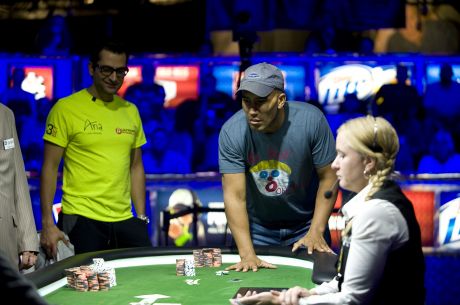Thinking Poker: A Study in Blind Defense

Tournaments are won in the trenches, by taking more than your share of pots and by making precise decisions even when they’re only for a few big blinds. A hand from last year’s European Poker Tour Vienna Main Event final table well illustrated the importance and the complexity of blind defenses, even those that don’t generate fireworks.
While the hand report may appear unremarkable at a glance, this one is particularly fun to think about, in part because we only know one hole card of the preflop raiser, and we have to consider how betting information and physical information interact.
The preflop blind defense
The blinds were 25,000/50,000 with a 5,000 ante and the table was still eight-handed when Timo Pfutzenreuter raised the button to 100,000. He held the Q♣, but the EPT Live hole card camera didn’t catch his second card. Oleksii Khoroshenin (the tournament’s eventual winner, pictured at right) called from the small blind with A♥10♠, and the big blind folded. Pfutzenreuter was playing roughly 4.5 million to Khoroshenin’s 2.5 million.
With position, at least one high card, and the knowledge that neither blind had a stack size conducive to moving in preflop, Pfutzenreuter made a standard raise. If he believed the blinds to be very good and very aggressive, he could be excused for folding the worst offsuit QxXx hands, but most often Pfutzenreuter would have been taking advantage of his position by opening the pot.
Some players have a policy of never calling the small blind in Khoroshenin’s spot here, but if he were going to call with anything, Ax10x was a reasonable candidate. With such strong high-card power the hand plays well after the flop, and it hits different flops from the ones hit by hands like 7x7x and 6x6x. Since Khoroshenin might also call with those medium pairs, Ax10x-offsuit in this situation provides some “flop coverage” by having value on boards like AxJx2x and Jx10x3x that are trouble for medium pairs.
When you are out of position or otherwise disadvantaged in a pot, it’s especially important to disguise your holdings by playing different kinds of hands the same way. Just playing more hands isn’t enough — they ought to play differently enough that you can make credible threats on many different boards and board textures.

If Khoroshenin were going to call with his middle pairs, he also had some reason to call with high-card hands. Ax10x-offsuit was a good candidate for such a hand because it plays well but is not so strong that he was giving too much up by not reraising.
Continuing on the flop
The flop came 5♥8♦8♠. Khoroshenin checked, Pfutzenreuter bet 140,000, and Khoroshenin called. We never would find out what Pfutzenreuter’s second card was, but his bet makes sense even without knowing that fact. With Qx3x and other junk hands he would have wanted to win the pot immediately, and with his best hands he would have wanted both to get value and (in the case of AxQx) protect against free cards.
There are some exceptions, however. If Khoroshenin’s possible hands were really just medium pairs and some Broadway hands, Pfutzenreuter shouldn’t have expected him to fold on this flop often (if ever). That would have been a reason to check his worst hands.
Checking the turn
The turn came the J♣ and both players checked. Pfutzenreuter’s check was almost instantaneous, which was uncommon at what overall was a slow-paced table.
I don’t know what this tendency means from Pfutzenreuter specifically, but you should note when your opponents make these kind of quick checks, especially when they are unusual in context. Sometimes this will be a sort of “weak means strong” tell, indicating a medium-strength hand with which they want to call a river bet. From other opponents it means that they really want to check. Perhaps they picked up a gutshot they’re hoping to hit and they consider a bluff hopeless.
I wouldn’t be surprised if Pfutzenreuter had either AxQx (a medium-strength hand planning to call a river bet) or Qx9x/Qx10x (a turned gutshot) here. Of course, I don’t know Pfutzenreuter’s specific tendencies, but this is the sort of thing I would be thinking about at the table. Note also that it makes sense for Pfutzenreuter to have given up frequently with his worst hands, so (disregarding the speed of the action) the check made sense for many of Pfutzenreuter’s possible queens.
Leading on the river
Khoroshenin then hit the 10♦ on the river to pair his ten, and he faced an interesting decision on the 5♥8♦8♠J♣10♦ board.
Though it might seem too passive, I think checking is a good standard play. Given the actions up to the river, Khoroshenin figured to have plenty of medium-strength hands, whereas Pfutzenreuter would have had a broader mix of busted, medium-strength, and strong hands. In such a situation, Pfutzenreuter would have been able to value bet with most (though not all) of the hands that were good enough to call a bet from Khoroshenin. Meanwhile, Khoroshenin does better to check and call than to bet himself, because he can get action from some bluffs that will otherwise simply fold.

Instead, Khoroshenin made a bet of 175,000 and won the pot when Pfutzenreuter folded. Although I take checking to be a good standard play, Pfutzenreuter’s behavior on the turn might have caused me to bet here, too.
If I have some extra reason to put my opponent on hands like Qx10x, Qx9x, and AxQx, a bet makes more sense. The 16 combinations of AxQx will (under these assumptions) call instead of check, Qx10x calls when it would have bet, and Qx9x (probably) raises when it would have bet. If I bet-fold, I lose the same money that I would have by check-calling against Qx9x; I break even against Qx10x; and I do much better against AxQx.
Conclusion
I certainly don’t attribute this exact thought process to Khoroshenin, and a full analysis of this situation would require us to think about bet sizing, too. But this hand remains a good example both of the intricacy of small pots and of how physical information interacts with betting information in poker hands.
As Andrew Brokos and I emphasize in our , player reads and physical information rapidly complicate situations, and the pressure of tournament play will often cause your opponents to give away useful physical information. Because of these complications — and because of the intrinsic importance of small pots to tournament play — even basic blind defenses are a worthy object of study for beginners and experienced players alike.
Be sure to check out Nate and Andrew Brokos on the Thinking Poker podcast, and for more from Nate visit his blog at natemeyvis.com.
Get all the latest PokerNews updates on your social media outlets. on Twitter and find us on both and !








